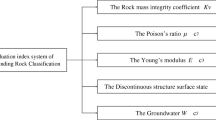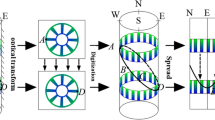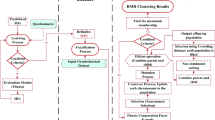Abstract
Rock mass quality classification is essential in rock engineering. In practical engineering the parameters of rock mass vary with sampling disturbance and testing instruments, however obey a certain distribution. In other words, the classification of rock mass quality includes an uncertainty caused by the randomness of the parameters of the rock mass in geological formations. Traditional rock mass classification methods ignore the effect of this parameter uncertainty. In this paper, we propose a new method for evaluating rock mass quality considering the effect of parameter uncertainty through a rigorous reliability analysis. The weights of the classification system indexes are obtained using the game theory, combined with the technique for order preference by similarity to ideal solution (TOPSIS) in determining the limit-state function for reliability analysis. Stochastic uncertainty analysis is performed based on Monte Carlo simulation (MCS) and the limit-state function established by TOPSIS. The rock mass quality classification grade is obtained based on the probability calculation. The TOPSIS model with accurate game theory weighting is evaluated using 25 sets of samples. The results confirmed the reliability of the model. In a case study of rock mass surrounding a cavern, we verified the proposed rock quality classification method using certainty and uncertainty methods in MATLAB. The results demonstrate that the MCS–TOPSIS coupled model is efficient and accurate for classifying rock mass quality, and this approach is easy to implement.




Similar content being viewed by others
References
Akkoyun O, Toprak ZF (2012) Fuzzy-based quality classification model for natural building stone blocks. Eng Geol 133:66–75
Akyol E, Kaya A, Alkan M (2016) Geotechnical land suitability assessment using spatial multi-criteria decision analysis. Arab J Geosci 9:498
Alberto R, Domenico C (2002) Probabilistic modeling of uncertainties in earthquake-induced landslide hazard assessment. Comput Geosci 28:735–749
Barton NR, Lien R, Lunde J (1974) Engineering classification of rock masses for the design of tunnel support. Rock Mech 6(4):189–239
Bieniawski ZT (1978) Determining rock mass deformability: experience from case histories. Int J Rock Mech Min Sci Geomech Abstr 15(5):237–247
Cen DF, Huang D (2017) Direct shear tests of sandstone under constant normal tensile stress condition using a simple auxiliary device. Rock Mech Rock Eng 50(6):1425–1438
Ching JY, Kok KP, Shih H (2016) Impact of statistical uncertainty on geotechnical reliability estimation. J Eng Mech 142(6):04016027. https://doi.org/10.1061/(ASCE)EM.1943-7889.0001075
Deere DU (1964) Technical description of rock cores for engineering purposes. Rock Mech Eng Geol 1(1):16–22
Deere DU, Hendron AJ, Patton FD, Cording EJ (1967) Design of surface and near surface construction in rock. In: Proceedings of the 8th U.S. symposium on rock mechanics failure and breakage of rock. American Institute of mining, metallurgical and petroleum engineers, Inc., New York
Gholami R, Rasouli V, Alimoradi A (2013) Improved RMR rock mass classification using artificial intelligence algorithms. Rock Mech Rock Eng 46:1199–1209
Gözde PY, Haluk A (2014) Landfill site selection utilizing TOPSIS methodology and clay liner geotechnical characterization: a case study for Ankara, Turkey. Bull Eng Geol Environ 73:369–388
Hoek E, Bray JW (1981) Rock slope engineering. The Institute of Mining and Metallurgy, London
Huang SZ, Chang JX, Leng GY, Huang Q (2015) Integrated index for drought assessment based on variable fuzzy set theory: a case study in the Yellow River basin, China. J Hydrol 527:608–618
Hwang C, Yoon K (1981) Multiple attribute decision making: methods and applications. Springer, New York
Jain V, Sangaiah AK, Sakhuja S, Thoduka N, Aggarwal R (2016) Supplier selection using fuzzy AHP and TOPSIS: a case study in the indian automotive industry. Neural Comput Appl 11:1–10
Jalalifar H, Mojedifar S, Sahebi AA, Nezamabadi H (2011) Application of the adaptive neuro-fuzzy inference system for prediction of a rock engineering classification system. Comput Geotech 38:783–790
Kang ZQ, Feng XT, Zhou H (2006) Application of extenics theory to evaluation of underground cavern rock quality based on stratification analysis method. Chin J Rock Mech Eng 25:3687–3693 (In Chinese)
Lai CG, Chen XH, Chen XY, Wang ZL, Wu XS, Zhao SW (2015) A fuzzy comprehensive evaluation model for flood risk based on the combination weight of game theory. Nat Hazards 77:1243–1259
Liu YC, Chen CS (2007) A new approach for application of rock mass classification on rock slope stability assessment. Eng Geol 89:129–143
Liu ZX, Dang WG (2014) Rock quality classification and stability evaluation of undersea deposit based on M-IRMR. Tunn Undergr Space Technol 40:95–101
Liu F, Zhao SZ, Weng MC, Liu YQ (2017) Fire risk assessment for large-scale commercial buildings based on structure entropy weight method. Saf Sci 94:26–40
Mehmet LS, Vedat D (2004) Data driven bivariate landslide susceptibility assessment using geographical information systems: a method and application to Asarsuyu catchment, Turkey. Eng Geol 71:303–321
Mert E, Yilmaz S, Inal M (2011) An assessment of total RMR classification system using unified simulation model based on artificial neural networks. Neural Comput Appl 20:603–610
Mojtaba G, Kamran G, Mostafa J, Siamak A (2011) A multi-dimensional approach to the assessment of tunnel excavation methods. Int J Rock Mech Min Sci 48:1077–1085
Rad HN, Jalali Z, Jalalifar H (2015) Prediction of rock mass rating system based on continuous functions using Chaos-ANFIS model. Int J Rock Mech Min Sci 73:1–9
Roszkowska E, Kacprzak D (2016) The fuzzy saw and fuzzy TOPSIS procedures based on ordered fuzzy numbers. Inf Sci 369:564–584
Saideep N, Sankaran M (2016) Reliability analysis under epistemic uncertainty. Reliab Eng Syst Saf 155:9–20
Sangaiah AK, Gopal J, Basu A, Subramaniam PR (2015) An integrated fuzzy DEMATEL, TOPSIS, and ELECTRE approach for evaluating knowledge transfer effectiveness with reference to gsd project outcome. Neural Comput Appl 28:111–123
Seaberg D, Devine L, Zhuang J (2017) A review of game theory applications in natural disaster management research. Nat Hazards 89:1461–1483
Selvachandran G, Peng X (2018) A modified TOPSIS method based on vague parameterized vague soft sets and its application to supplier selection problems. Neural Comput Appl. https://doi.org/10.1007/s00521-018-3409-1
Umer J, Riaz MM, Ghafoor A, Cheema TA (2017) Weighted fusion of MRI and PET images based on fractal dimension. Multidimens Syst Signal Process 28:679–690
Wang Y, Adeyemi EA (2016a) Evaluating variability and uncertainty of geological strength index at a specific site. Rock Mech Rock Eng 49:3559–3573
Wang Y, Adeyemi EA (2016b) Bayesian characterization of correlation between uniaxial compressive strength and Young’s modulus of rock. Int J Rock Mech Min Sci 85:10–19
Wang MW, Xu XY, Li J, Jin JL, Shen FQ (2015) A novel model of set pair analysis coupled with extenics for evaluation of surrounding rock stability. Math Probl Eng 2015:892549
Wang QQ, Li WP, Yan SS, Wu YL, Pei YB (2016a) GIS based frequency ratio and index of entropy models to landslide susceptibility mapping (Daguan, China). Environ Earth Sci 75:780
Wang Y, Cao ZJ, Li DQ (2016b) Bayesian perspective on geotechnical variability and site characterization. Eng Geol 203:117–125
Wu LZ, Zhou Y, Sun P, Shi JS, Liu GG, Bai LY (2017) Laboratory characterization of rainfall-induced loess slope failure. Catena 150:1–8
Wu LZ, Shao GQ, Huang RQ, He Q (2018a) Overhanging rock: theoretical, physical and numerical modeling. Rock Mech Rock Eng 51(11):3585–3597
Wu LZ, Zhang LM, Zhou Y, Xu Q, Liu GG, Bai LY (2018b) Theoretical analysis and model test for rainfall induced shallow landslides in the red-bed area of Sichuan. Bull Eng Geol Environ 77(4):1343–1353
Wu LZ, Deng H, Huang RQ, Zhang LM, Guo XG, Zhou Y (2019) Evolution of lakes created by landslide dams and the role of dam erosion: a case study of the Jiajun landslide on the Dadu River, China. Quat Int. https://doi.org/10.1016/j.quaint.2018.08.001
Zhang W, Li XB, Gong FQ (2008) Stability classification model of mine-lane surrounding rock based on distance discriminant analysis method. J Central South Univ Technol 15(1):117–120
Acknowledgements
The research reported in this paper was supported by the National Key Research and Development Program of China (no. 2018YFC1504702), the National Natural Science Foundation of China (no. 41672282, 41772334), State Key Laboratory of Geohazard Prevention and Geoenvironment Prevention Independent Research Project (no. SKLGP2017Z003), the Youth Science and Technology Innovation Team in Sichuan Province (no. 2015TD0030), and the first author thanks the Innovative Team of Chengdu University of Technology.
Author information
Authors and Affiliations
Corresponding author
Ethics declarations
Conflict of interest
The authors of this manuscript declare that there is no conflict of interest regarding the publication of this manuscript.
Additional information
Publisher’s Note
Springer Nature remains neutral with regard to jurisdictional claims in published maps and institutional affiliations.
Rights and permissions
About this article
Cite this article
Wu, L.Z., Li, S.H., Zhang, M. et al. A new method for classifying rock mass quality based on MCS and TOPSIS. Environ Earth Sci 78, 199 (2019). https://doi.org/10.1007/s12665-019-8171-x
Received:
Accepted:
Published:
DOI: https://doi.org/10.1007/s12665-019-8171-x




